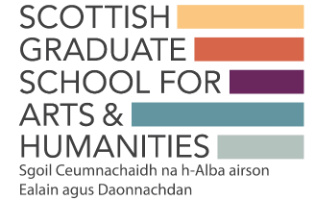Historic Environment Scotland
Published: 4 October 2023
A Scottish Stone Story - Angus Sandstone. The candidate could work remotely or could be office based (or hybrid). The candidate could work at either Longmore House (Edinburgh) or the HES Engine Shed (Stirling). Though some travel will be required across Angus and Dundee as part of the research.
Location
The candidate could work remotely or could be office based (or hybrid). The candidate could work at either Longmore House (Edinburgh) or the HES Engine Shed (Stirling). Though some travel will be required across Angus and Dundee as part of the research.
Project
Scotland has a rich stone-built heritage, and its geology has contributed to the character of its towns and cities. These industries are a big part of Scotland’s industrial heritage, where each town and city would have had quarries producing building stone (historically, over 2,000 quarries produced stone, but we are now down to less than 20 in operation). Much has been written about the Scottish stone industry, and especially about the use of Aberdeen Granite and Scottish Sandstones, and the slate Islands. However, there was a comparable industry in Angus that had a big an impact not just locally but internationally, and which has not been documented to the same level. These quarries are among the oldest worked in Scotland, and produced huge quantities of stone and shipped it across the world (reportedly used to pave Cologne Cathedral and the roof of the Vatican).
The purpose of the research:
The research project will help HES to understand and document the history of Angus Sandstone. It will help us to understand the
history of the industry, where and how its products were used, and the economic and social impacts this had in local areas.
We anticipate the project forming three stages:
Stage 1
• A rapid assessment exercise to understand and map existing resources for use in understanding the history and significance of the Angus Sandstone industry (e.g. archival sources, contemporary newspaper or film reports, evidence in printed material such as the Statistical Accounts)
Stage 2
Archival and other primary research to understand the industry
and its social and economic history, leading to production of a
short, accessible output suitable for publication on the HES
website (Circa 5000 words (20-30 pages). The written output
might explore themes such as:
• The timeline of the industry
• How Angus Sandstone quarries worked
• The stories behind the people who owned and worked the quarries
• The impact of the quarries on local communities, e.g. on housing, religion, farming, language etc.
• Why quarries closed, and what happened to local communities as a result
• The impact of quarried stone on the built environment of the local area, and how its legacy should be managed going forward
• The impact that new machinery or ways of working had on the quarries and their workers
Stage 3
Production of a list of recommendations for future research on Angus Sandstone.
Outputs
The researcher will produce three main outputs:
• A list of sources, including archival holdings and their extent
• A short, accessible written narrative summarising the findings of their primary research into the history and significance of the Angus Sandstone industry
• A list of recommendations for future research into the industry
The researcher would engage with local history groups as well as heritage professionals and historians to develop the publication which would be a free downloadable pdf resource that would be made available through HES networks. A comparable publication would be the publication ‘Islands that roofed the world 2001’. External engagement Outreach - Delivery of a presentation on the
project locally in person or online.
Timescale
- Start date Flexible
- End date Flexible (within 8 months of start date).
Could accommodate all the approaches below. Would depend on the candidate’s capacity.
- Single block of 12 weeks
- Multiple shorter blocks
- Longer less intensive engagement, e.g., 2 day per week, one week per month
- Mixture of the above
Benefits to the Researcher
The researcher will gain first-hand experience of applying historical research within a practical heritage setting, and build understanding of the concept of cultural significance and how it informs heritage policy. Through their work, the researcher will be able to develop their networks through working with a range of stakeholders, and gain experience of sharing research findings with communities.
Depending on the researcher’s existing skillset, there may also be opportunity to learn practical heritage surveying and recording
skills.
Key Relationships
During the placement the candidate is expected to work with a variety of community groups, Geology professionals, Historians, Industrial heritage groups etc.
Historic Environment Scotland
https://www.historicenvironment.scot/
British Geological Survey
https://www.bgs.ac.uk/
Denfind Stone
https://denfindstone.co.uk/
Carmylle Heritage Society
http://www.carmyllieheritage.co.uk
Person Specification
|
E |
D |
Essential/Desirable |
E |
D |
Essential/Desirable |
|
A1 – Knowledge Base |
C1 – Professional Conduct |
||||
|
|
X |
Subject Knowledge |
|
|
Health and Safety |
|
|
X |
Research methods – theoretical knowledge |
|
|
Ethics, principles and sustainability |
|
|
X |
Research methods – Practical application |
|
|
Legal requirements |
|
|
X |
Information Seeking |
|
|
IPR and copyright |
|
X |
|
Information literacy and management |
|
|
Respect and confidentiality |
|
|
|
Languages |
|
|
Attribution and co-authorship |
|
|
|
Academic literacy and numeracy |
|
|
Appropriate practice |
|
A2 – Cognitive abilities |
C2 – Research management |
||||
|
|
|
Analysing |
X |
|
Research Strategy |
|
|
|
Synthesising |
X |
|
Project planning and delivery |
|
X |
|
Critical thinking |
|
|
Risk management |
|
X |
|
Evaluating |
|
|
|
|
|
|
Problem Solving |
|
|
|
|
A3 – Creativity |
C3 – Finance, funding & resources |
||||
|
|
X |
Inquiring minds |
|
|
Income and funding generation |
|
|
|
Intellectual insight |
|
|
Financial management |
|
|
|
Innovation |
|
|
Infrastructure and resources |
|
|
X |
Argument construction |
|
|
|
|
|
|
Intellectual risk |
|
|
|
|
B1 – Personal qualities |
D1 – Working with others |
||||
|
X |
|
Enthusiasm |
|
|
Collegiality |
|
X |
|
Perseverance |
|
X |
Team working |
|
|
|
Integrity |
|
|
People management |
|
|
X |
Self-confidence |
|
|
Supervision |
|
|
|
Self-reflection |
|
|
Mentoring |
|
|
|
Responsibility |
|
|
Influence and leadership |
|
|
|
|
|
X |
Collaboration |
|
|
|
|
|
|
Equality and diversity |
|
B2 – Self management |
D2 – Communication & dissemination |
||||
|
|
|
Preparation and prioritisation |
|
|
Communication methods |
|
|
|
Commitment to research |
|
|
Communication media |
|
|
|
Time management |
|
|
Publication |
|
|
|
Responsiveness to change |
|
|
|
|
|
|
Work-life balance |
|
|
|
|
B3 – Professional & career development |
D3 – Engagement and impact |
||||
|
|
|
Career management |
|
|
Teaching |
|
|
|
Continuing professional development |
|
X |
Public Engagement |
|
|
|
Responsiveness to opportunities |
|
|
Enterprise |
|
X |
|
Networking |
|
|
Policy |
|
|
|
Reputation and esteem |
|
|
Society and culture |
|
|
|
|
|
|
Global citizenship |
Click here to apply
First published: 4 October 2023



